Making a Comeback-2 |
||
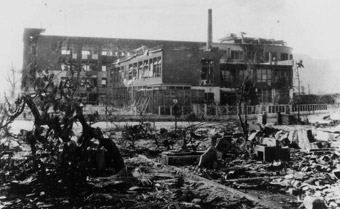 Thanks to the desperate fire-fighting efforts of the staff, the first floor and basement were rescued from the flames. The four-story building to the rear is the Hiroshima Communications Bureau. Early October 1945.
Thanks to the desperate fire-fighting efforts of the staff, the first floor and basement were rescued from the flames. The four-story building to the rear is the Hiroshima Communications Bureau. Early October 1945.Taken by Toshio Kawamoto Courtesy of the Association of the Photographers of the Atomic (Bomb) Destruction of Hiroshima 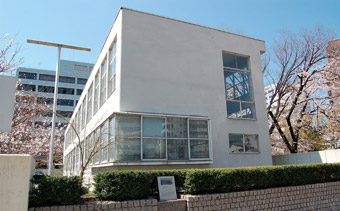 The foreground of the photograph shows the re-created operating room.
The foreground of the photograph shows the re-created operating room.April 2008. |
Hiroshima Posts and Telecommunications Hospital
The new building featured especially large windows which were shattered by the blast, the window frames bent like soft candy. Starting shortly after the bombing, a crowd of injured people began to pour in. Day and night, staff members feverishly provided aid.
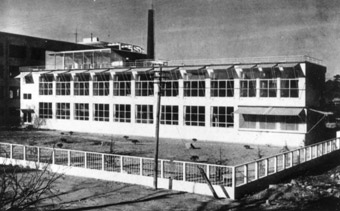 External view of south side. Third floor was a sun parlor. 1935. From International Architecture Vol. 12 issued in 1936 
* Location: 19-16 Higashi-hakushima-cho, Naka-ku * Distance from hypocenter: 1,370 meters * Name at time of bombing: Hiroshima Posts and Telecommunications Hospital * Structure/number of stories: Reinforced concrete, two stories with basement floor and partial third story * Completed: 1935 * Name when completed: Hiroshima Posts and Telecommunications Clinic * Current status: A portion of the former outpatient ward has been preserved. The bombing-related materials room and re-created operating room are open to visitors. |
|
 The former power-generating wing is on the hypocenter side.
The former power-generating wing is on the hypocenter side. The roof is stripped off. Around November 1945. Taken by U.S. Army 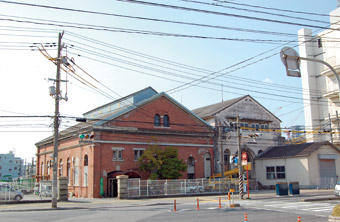 The former boiler wing (left) is currently used as an office.
The former boiler wing (left) is currently used as an office. April 2008. |
Hiroshima Electric Railway Co., Ltd., Sendamachi Substation and office
Streetcars began running in Hiroshima in 1912. This two-wing building originally housed generator and boiler for generating electricity. By 1934 the power station had deteriorated so the generating functions were terminated and it became a substation. Although the roof was stripped off by the atomic bomb, the building did not collapse. It resumed operations and played an important role after the bombing. The former boiler wing (left side of photo) is now used as an office, and the bent roof trusses can be seen. The former power-generating wing (right side of photo) is still an active substation. 
* Location: 2-9-29 Higashi-senda-machi, Naka-ku * Distance from hypocenter: 1,920 meters * Name at time of bombing: Hiroshima Electric Railway Sendamachi Substation * Structure/number of stories: Brick, one story with basement floor, two wings * Completed: 1912 * Name when completed: Hiroshima Electric Railroad Thermal Power Station * Current status: Office appears on left side of photo, and substation on right. |
|
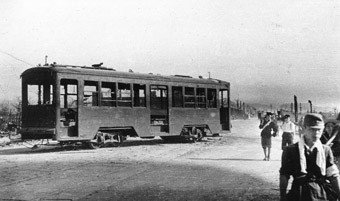 Streetcar No. 651 shown running near the current location of Chugoku Electric Power Co., Inc.
Streetcar No. 651 shown running near the current location of Chugoku Electric Power Co., Inc. The blast knocked it far off the rails. Behind it is the Takanobashi district. August 9, 1945. Taken by Mitsugi Kishida / Courtesy of Teppei Kishida * Vehicle name: 650-model electric streetcar * Current status: Four cars currently exist. Two bomb-damaged streetcars are still in operation. A third is kept at the Eba Depot, and the forth is exhibited at the Hiroshima City Transportation Museum. |
650-model electric streetcar
The bombing killed 211 employees of the Hiroshima Electric Railway, and 108 of 123 streetcars were damaged. About forty people, including people from the Tokyo Telegraph Corps, began making emergency repairs. On August 9, three days after the bombing, shuttle service from Koi to Nishi-tenma-cho began, giving hope to many city residents.
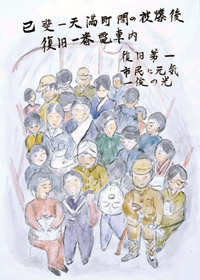
A lot of the passengers had nothing to say. Some were amazed: “The streetcars are already running?” Others said, “I’m afraid to cross the rail bridges by myself.” People with burns, people with purple spots. Many couldn’t pay the fare. “Thank you very much,” they said, “I’m sorry.” (Taken from Testimonies by Survivors Exposed in Streetcars; Hiroshima Electric Railway Co., Ltd., December 15, 1985; page 112) Drawn by Haruno Horimoto (Age at bombing-16; at drawing-72) |
|
Wooden Building Now |
||
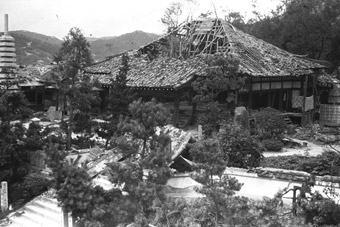 The roof of the main hall was badly damaged by the blast. September 18-25, 1945. Taken by Eiichi Matsumoto Courtesy of the Asahi Shimbun Company 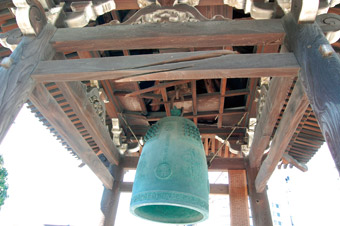 Bell tower with beam as damaged by the blast. May 2008.
Bell tower with beam as damaged by the blast. May 2008.
|
Tamonin Temple Bell Tower
The Tamonin Temple has been in its current location on Hijiyama Hill since 1604. Surrounded by trees at the foot of the hill and thought to be relatively safe, it was designated as an emergency refuge by the wartime Prefectural Government. The atomic bomb heavily damaged the main hall and priests' quarters, but the structure did not burn. In the evening of August 6, a "Prefectural Air Defense Headquarters" was established there that served as a relief supply center and distributed rice balls. The next morning (August 7), the Prefectural Air Defense Headquarters relocated to the Higashi Police Station (now, Kanayama-cho). After the war, the main hall was repaired, but later burned down. Of the A-bombed wooden structures that currently exist, the bell tower was closest to the hypocenter. It has been preserved with its roof and ceiling as they appeared after the bombing. The bell was confiscated by the government, but in 1949 a "Bell of Peace" was manufactured that rings each morning and evening.  * Location: 7-10 Hijiyama-cho, Minami-ku * Distance from hypocenter: 1,750 meters * Name at time of bombing: Tamonin Temple Bell Tower * Structure: Wooden * Completed: 1934 * Name when completed: Tamonin Temple Bell Tower * Current status: Preserved in same condition as when bombed. |
|
